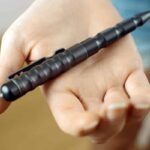I take Q’s The Fix rifle in 8.6 Blackout to the range to test the best ways to maximize its subsonic and supersonic capabilities.
Up until the introduction of the 8.6 Blackout cartridge I never had much interest in subsonic centerfire rifle cartridges. This was mostly because of the lackluster supersonic capabilities of the .300 Blackout and even the much newer .338 ARC. Once either cartridge is combined with a compact short-barreled-rifle (SBR) all you really have is a subsonic platform with limited application. The 8.6 Blackout is different, mostly because of its incredibly fast twist rate of 1 turn in 3 inches. From a terminal performance perspective this radically fast rotational velocity not only lets it outperform all other subsonic cartridges, but it also substantially increases its supersonic capabilities. That high performance dual use intrigues me.
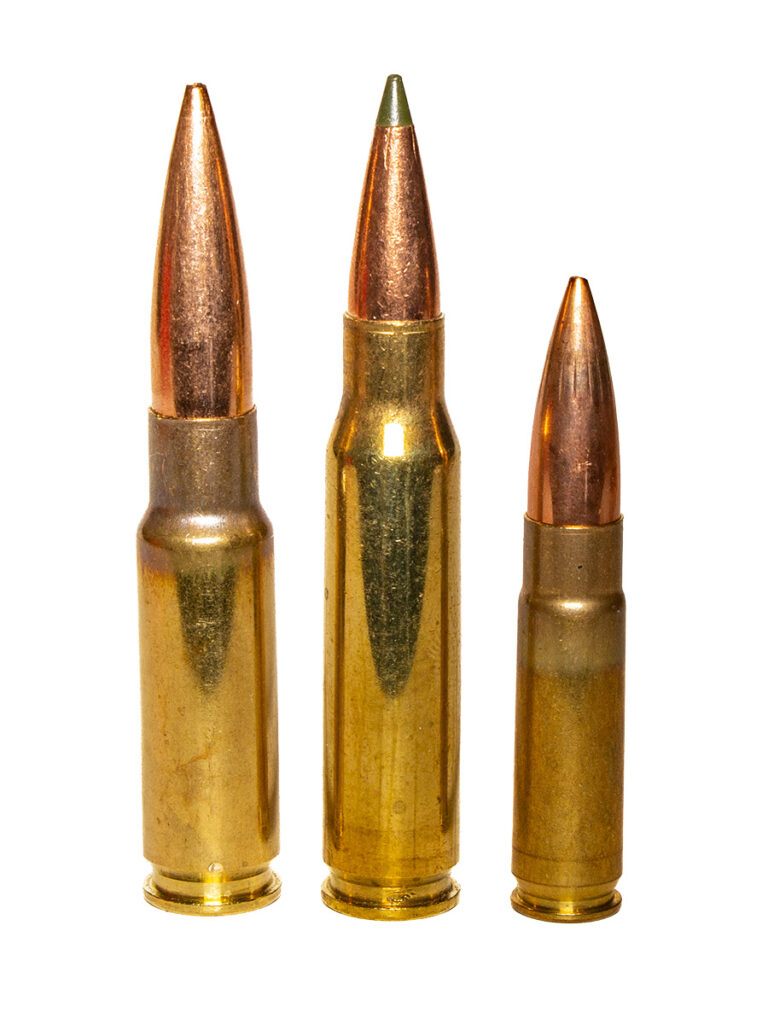
The 8.6 Blackout is a brainchild of Q, a firearms company in New Hampshire that’s probably best known for their Honey Badger SBR. I don’t know where the company came up with their odd name, but I do remember that Q was where James Bond got all his cool tools. At any rate, the founder of Q was also the founder of AAC (Advanced Armament Corporation) and the creator of the .300 Blackout. As you might guess, Q also makes the best rifle for the 8.6 Blackout cartridge. It’s called the Fix.
The Fix is very unique and unlike any other bolt-action rifle you’ve seen. It is built around an aluminum receiver, but, except for the trigger, all operational components are housed in the striker-fired bolt. It also has a folding stock that’s adjustable for length of pull and comb height, and the barrel system is modular, so the end user can swap barrels on their own. A Q Fix SBR in 8.6 Blackout with a 12-inch barrel only weighs 5.18 pounds, so even with a suppressor and a riflescope it’s still reasonably light for a rifle that powerful.
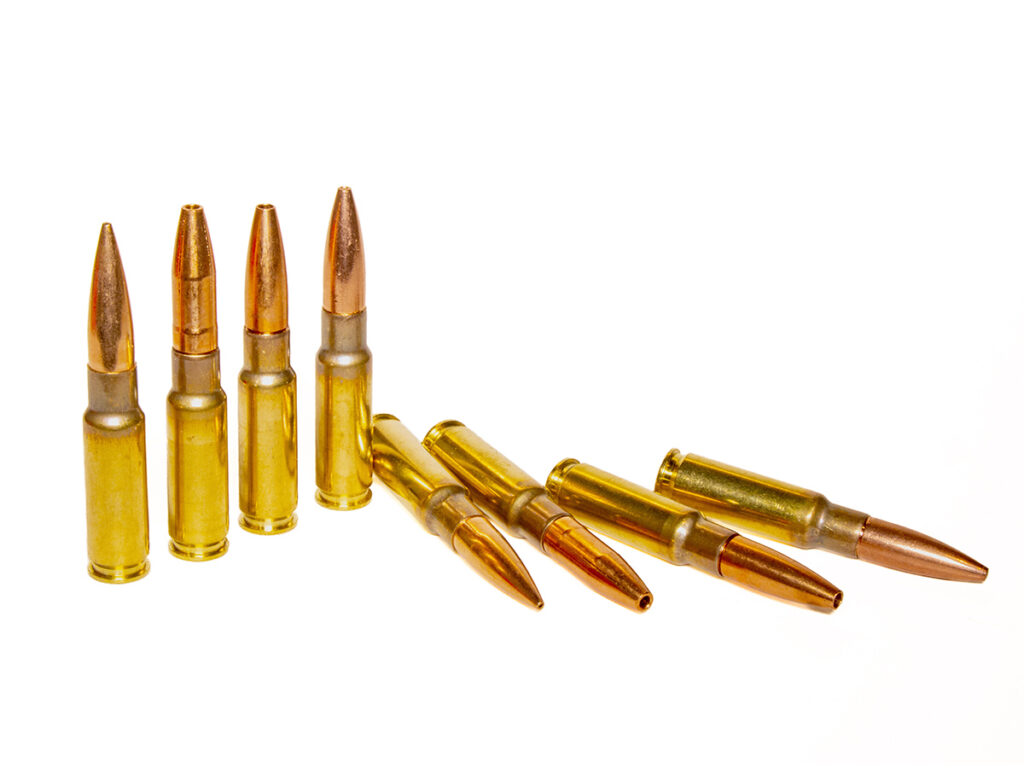

I’ve been working with one for about a year and wanted to maximize its usefulness by selecting a sight system that would allow me to go between subsonic and supersonic ammo without drastic sight alterations. In other words—ideally—I wanted to be able to shoot accurately, from the muzzle to 200 yards, and let the riflescope do my trajectory correction work for me. The first thing I needed to do to start down this road was establish the DOPE for super and subsonic loads so I could select a riflescope that would best pair with both, and the current best source for 8.6 Blackout ammo is Gorilla Ammunition.
Getting the DOPE
This is where things get a bit tricky because you’re dealing with trajectory correction at various distances, and this makes the click value of the riflescope change. For example, at 100 yards most riflescopes have a click value of ¼ MOA. This equates to about a quarter inch, but to be precise it equals 0.262 inch. At 50 yards, the riflescope has a click value of 0.131-inch (1/8th MOA) per click, at 75 yards the ¼ MOA click value equals 0.197 inch, and at 200 yards it’s 0.524 inch per click. It is also a bit complicated because you’re correcting for loads that shoot reasonably flat and for other loads with a rainbow trajectory.
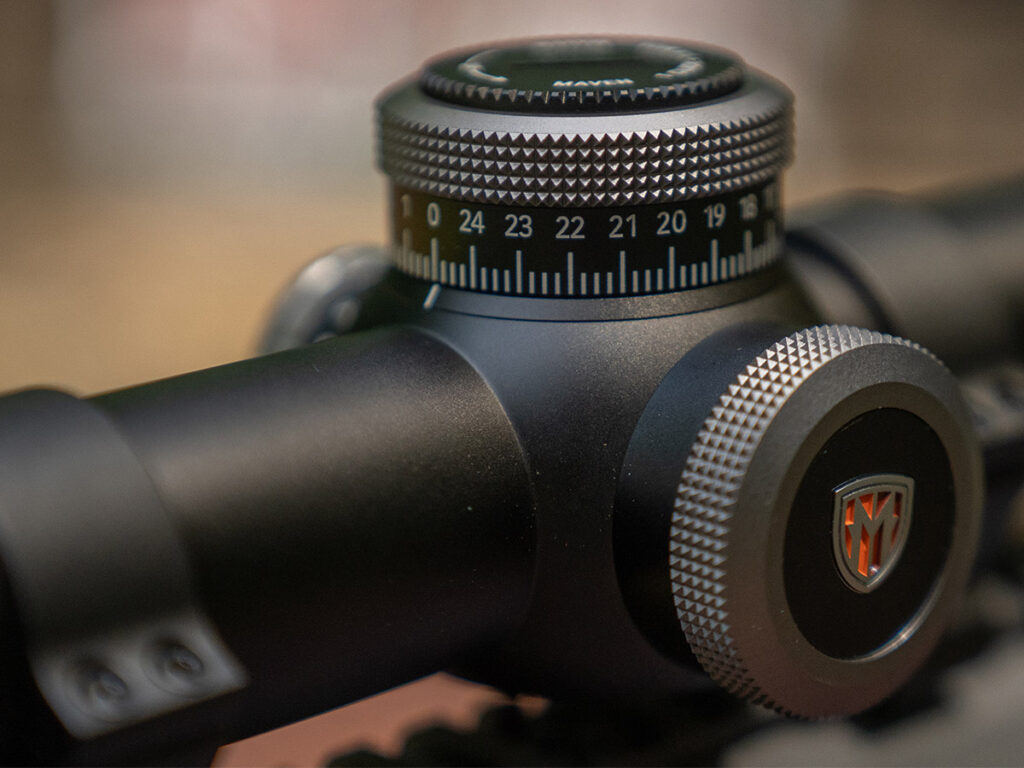

For my purposes, I decided on the 190-grain Fracturing supersonic load, which is what I zeroed the rifle for at 100 yards. Next, I wanted to know how much that load would drop at 200 yards. Shots on target confirmed this at about 7.5 inches. Since each elevation click equals 0.524-inch at 200 yards, I needed 14.31(15) clicks.
While I was at it, I also checked the drop of the 210-grain Barnes TSX load at 100 yards. With the rifle zeroed for the 190-grain Fracturing supersonic load, the 210-grain TSX load was 2 inches low at 100, and 9.0 inches low at 200. But I really wanted to be able to shoot accurately out to 100 yards with the 285-grain Fracturing subsonic load.
I started at 50 yards using the 100 yard zero for the 190-grain Fracturing supersonic load. At that distance the 285-grain Fracturing subsonic load impacted 5 inches low. The ¼ MOA click value of the scope at 50 yards is 0.131 inch, and to correct for 5 inches I needed 38 clicks. As it turned out, this was the same elevation correction I needed for the Gorilla subsonic 300-grain Sierra MatchKing load.
Next, I shot a target at 75 yards, and both the 285-grain Fracturing and 300-grain Sierra MatchKing subsonic loads struck the target right at about 12 inches low. The ¼ MOA click value at 75 yards equals 0.197 inch, which meant I needed to divide 12 inches by 0.197 to determine the number of clicks of correction needed. The math worked out to 60.91 or 61 clicks.
Finally, I was shooting the subsonic loads at 100 yards where I was also dealing with the common ¼ MOA (0.262-inch) per click correction. At that distance, the 300-grain Sierra MatchKing subsonic load was 17.5 inches low, so it required 67 clicks, and the 285-grain Fracturing subsonic load at 19 inches required 73 clicks.
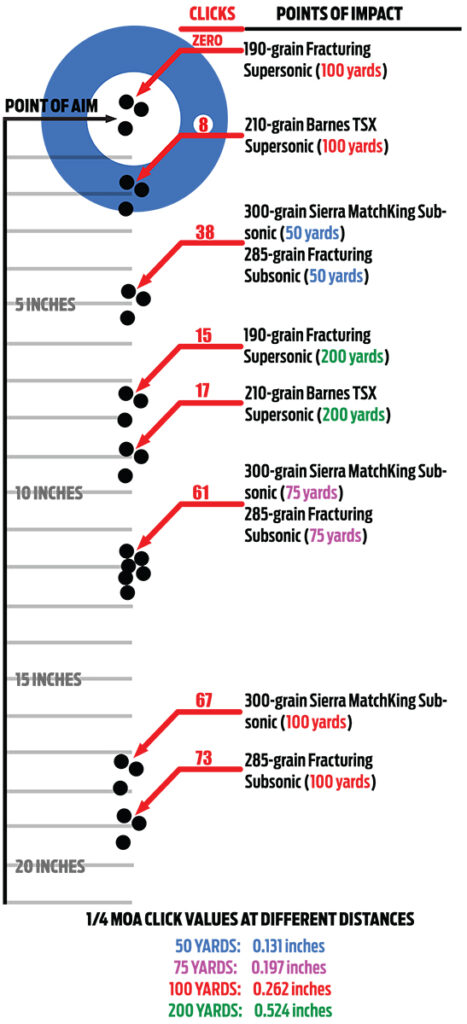

Any long-range shooter is familiar with an exercise like this; it’s called getting your DOPE (Data from Previous Engagement). The difference is that most long-range shooters are only working with a single load, and they’re also not trying to use a single zero for two different loads.
Another thing to consider is that the drop of your subsonic loads might not impact the target directly below their impact at close range or the impact of the supersonic load at its zero range. This can be a trait of the ammunition, but it’s more than likely an indicator your riflescope/reticle is not level, and when you’re applying click corrections, you’re minutely moving the reticle to the left or right.
DOPE Chart
| LOAD | DISTANCE (YARDS) | DROP (INCHES) | 1/4 MOA (INCHES) | CLICKS |
| 190-grain supersonic | 100 yards | -0- | 0.262 | 0 (0) |
| 210-grain supersonic | 100 yards | -2.0 | 0.262 | 7.63 (8) |
| 190-grain supersonic | 200 yards | -7.5 | 0.524 | 14.31 (15) |
| 210-grain supersonic | 200 yards | -9.0 | 0.524 | 17.17 (17) |
| 285-grain subsonic | 50 yards | -5.0 | 0.131 | 38.17 (38) |
| 285-grain subsonic | 75 yards | -12.0 | 0.197 | 60.91 (61) |
| 285-grain subsonic | 100 yards | -19.0 | 0.262 | 72.52 (73) |
| 300-grain subsonic | 50 yards | -5.0 | 0.131 | 38.17 (38) |
| 300-grain subsonic | 75 yards | -12.0 | 0.197 | 60.91 (61) |
| 300-grain subsonic | 100 yards | -17.5 | 0.262 | 66.79 (67) |
Finding a Scope
Once I had my DOPE, I then knew the maximum amount of elevation correction I needed. Since I wanted to shoot to 200 yards with supersonic loads and out to 100 yards with subsonic loads, I needed at least 18.5, or better yet, 19 MOA of correction. Most rifle scopes offer this much elevation adjustment in a single rotation, and some of the more modern riflescopes offer two rotations with almost double that amount. If you wanted to take the subsonic loads beyond 100 yards the additional—second rotation—adjustment would be necessary with the 8.6 Blackout.
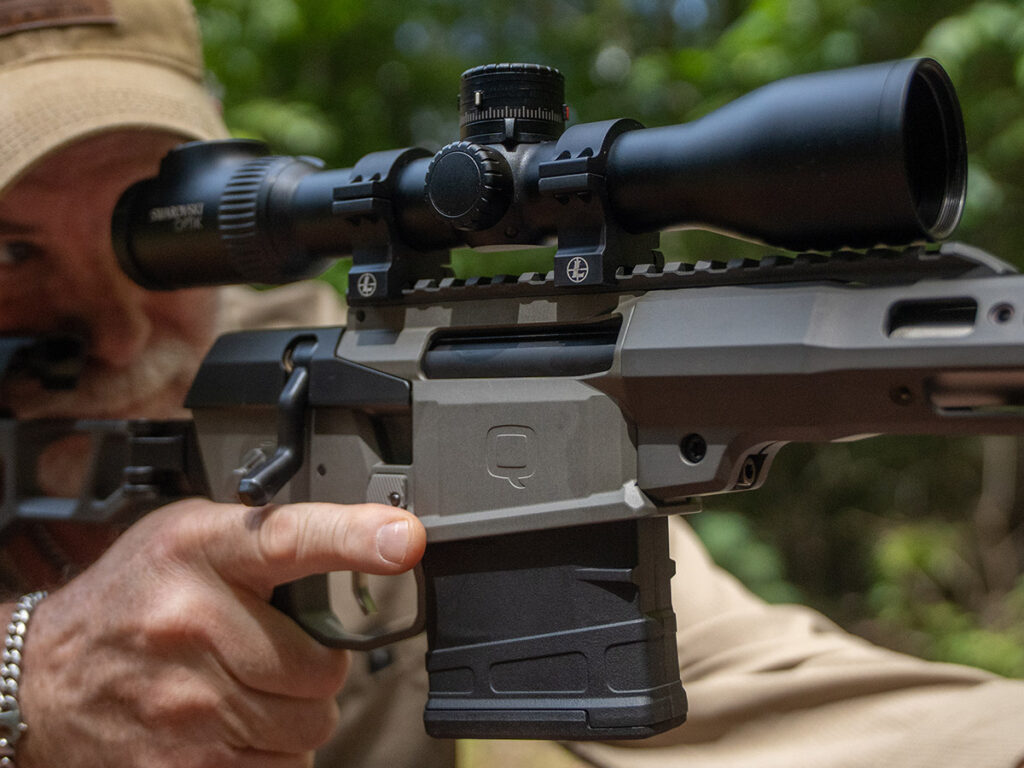

Swarovski’s Z5i + L BT
I first tried one of the new Swarovski Z5i + L BT riflescopes ($1,949) that comes with their self-customizing elevation correction turret that uses multiple small rings. After setting the zero for the 190-grain Fracturing supersonic load, I set a ring at 15 clicks for the 190-grain Fracturing supersonic load at 200 yards, and rings at 38, 61 and 73 clicks for the 285-grain subsonic load at 50, 75 and 100 yards, respectively. This riflescope was equipped with the illuminated plex-style reticle, so trajectory correction was only possible by clicking in a solution.
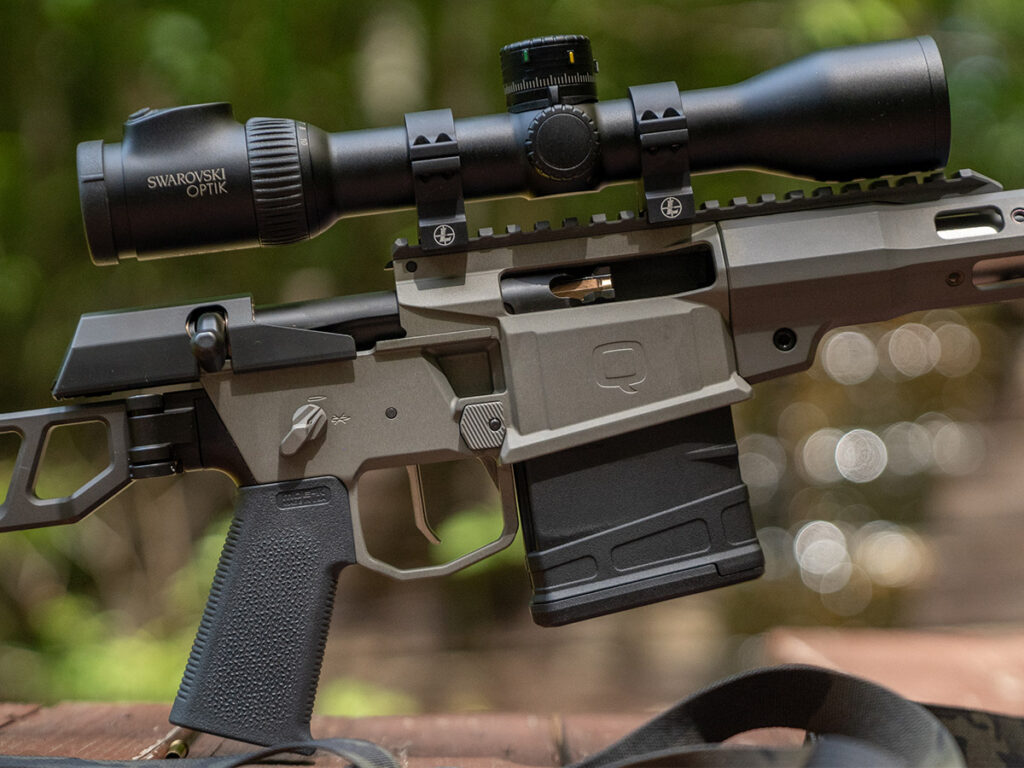

Maven’s RS.6 1-10x28mm
I switched to the new Maven RS.6 1-10x28mm riflescope ($1,600) that comes with the unique MOA3-LPI reticle. This is an MOA Christmas tree style reticle with elevation and windage correction, but it also very uniquely provides red or green illumination. This reticle offers 50 MOA of elevation and 20 MOA of windage correction, in 1 MOA increments, so it would be easy to correct for distance with either load. Of course, with 50 MOA of elevation correction in the turret, I could click-in corrections too.
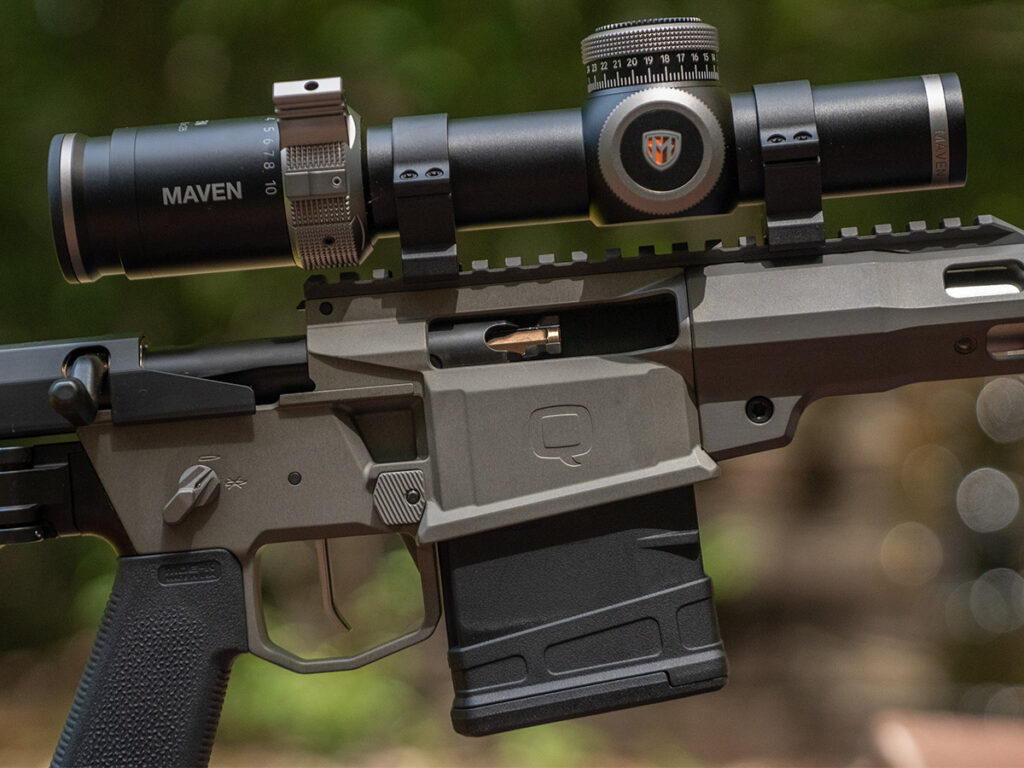

EOTech’s 3-9X32mm SFP
Then, I tried the new EOTech 3-9X32mm SFP riflescope which retails for $1,059. This is an unusual scope because it does not mount via rings. Instead, it uses a rail that interfaces with various height mini-ACOG mounts. The windage and elevation turrets are capped with this scope, but given its size and weight, it was the scope I really hoped worked with this rifle and cartridge. The reticle for the EOTech 3-9X32mm SFP is also an MOA reticle that’s illuminated, and it offers 30 MOA of elevation correction and 16 MOA of left and right windage correction.
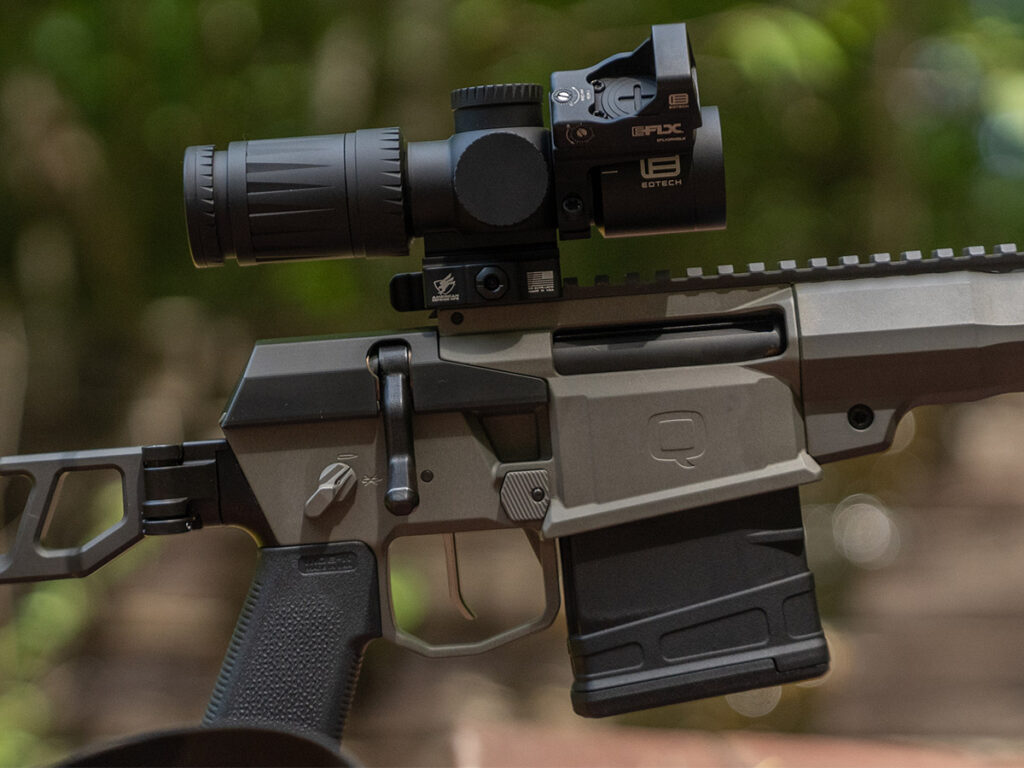

The EOTech has capped turrets, so dialing DOPE was not really an option. But the SFP’s reticle worked just fine for trajectory correction with both loads at the designated distances. However, without any numbering on the MOA hash marks I had to do some counting to select the correct one. Looking at the DOPE chart this seems complicated, but remember, based on my goals, I only wanted four trajectory corrections: 200 yards for the supersonic load, and 50, 75 and 100 yards for the subsonic load. This scope can also be had with a mount for an EOTech EFLX mini reflex sight and ring mount for an additional $370 extra. With the addition of this sight, I can make accurate shots at extremely close quarters just by slightly rotating the rifle and raising my head to look through the reflex sight.
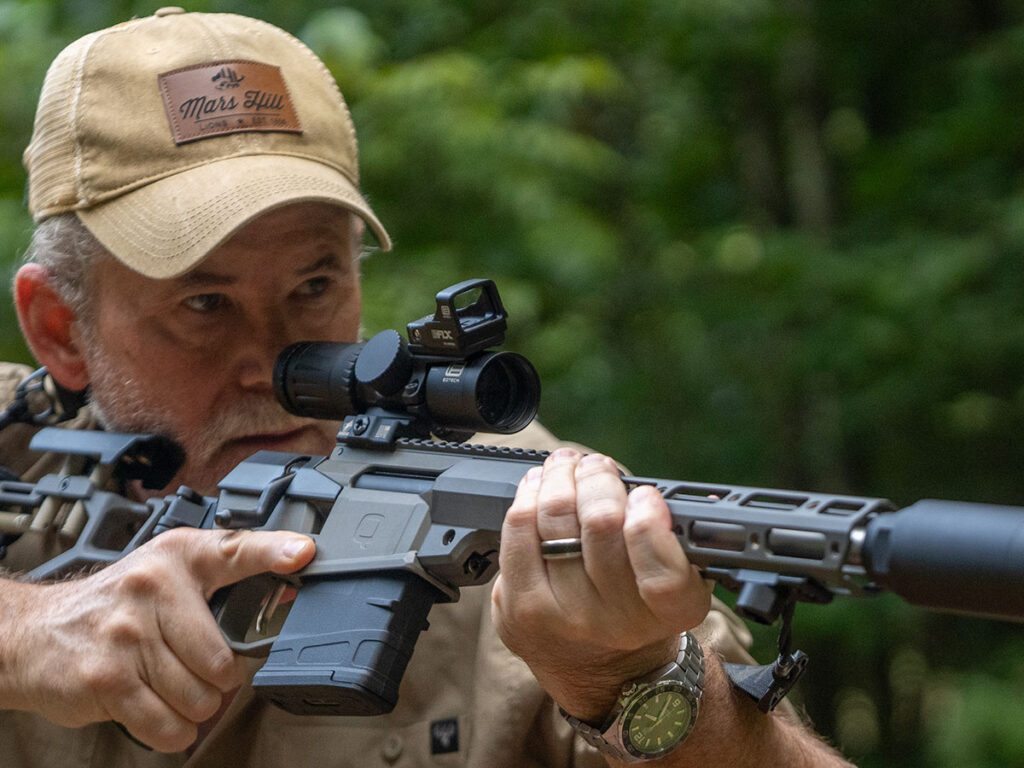

A Symbiotic Super/Sub System
With its fantastic varied applications, the Q Fix and the 8.6 Blackout cartridge can be used for hunting, recreation, and personal protection, and all this DOPE illustrates how you can maximize the system by using various optical sights. With the modern optics we have today, options seem endless. I really liked all three riflescopes I tried, and it may take some time for me to settle on which one I like best. No matter which way I go I’ll have a very symbiotic system that will allow me to accurately place slow and silent or fast and quiet bullets right where I need them out to 200 yards and beyond.
Shooting Results
| LOAD | VEL (fps) | ST DEV (fps) | ENG (ft-lbs) | PRECISION (Inches) |
| Gorilla 190-grain Fracturing | 2,013.2 | 10.7 | 1,709.7 | 1.69 |
| Gorilla 210-grain Barnes TSX | 1,927.8 | 8.5 | 1,732.6 | 1.12 |
| Gorilla 285-grain Fracturing | 881.6 | 30.9 | 492.4 | 1.64 |
| Gorilla 300-grain Sierra MatchKing | 917.3 | 30.9 | 561.1 | 2.88 |
| AVERAGE: | 1.83 |
Editor’s Note: This article originally appeared in the November 2025 issue of Gun Digest the Magazine.
More On Suppressors:
More On Suppressors:
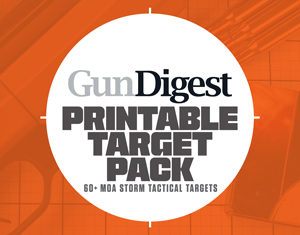

Next Step: Get your FREE Printable Target Pack
Enhance your shooting precision with our 62 MOA Targets, perfect for rifles and handguns. Crafted in collaboration with Storm Tactical for accuracy and versatility.
Subscribe to the Gun Digest email newsletter and get your downloadable target pack sent straight to your inbox. Stay updated with the latest firearms info in the industry.
Read the full article here






